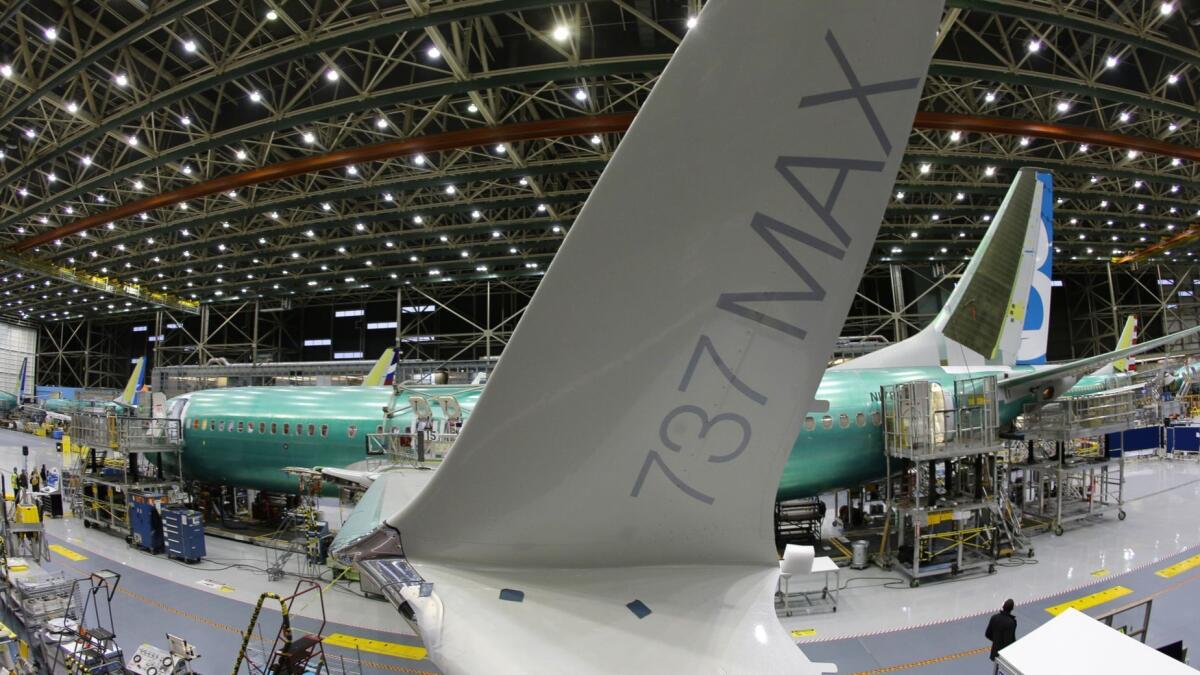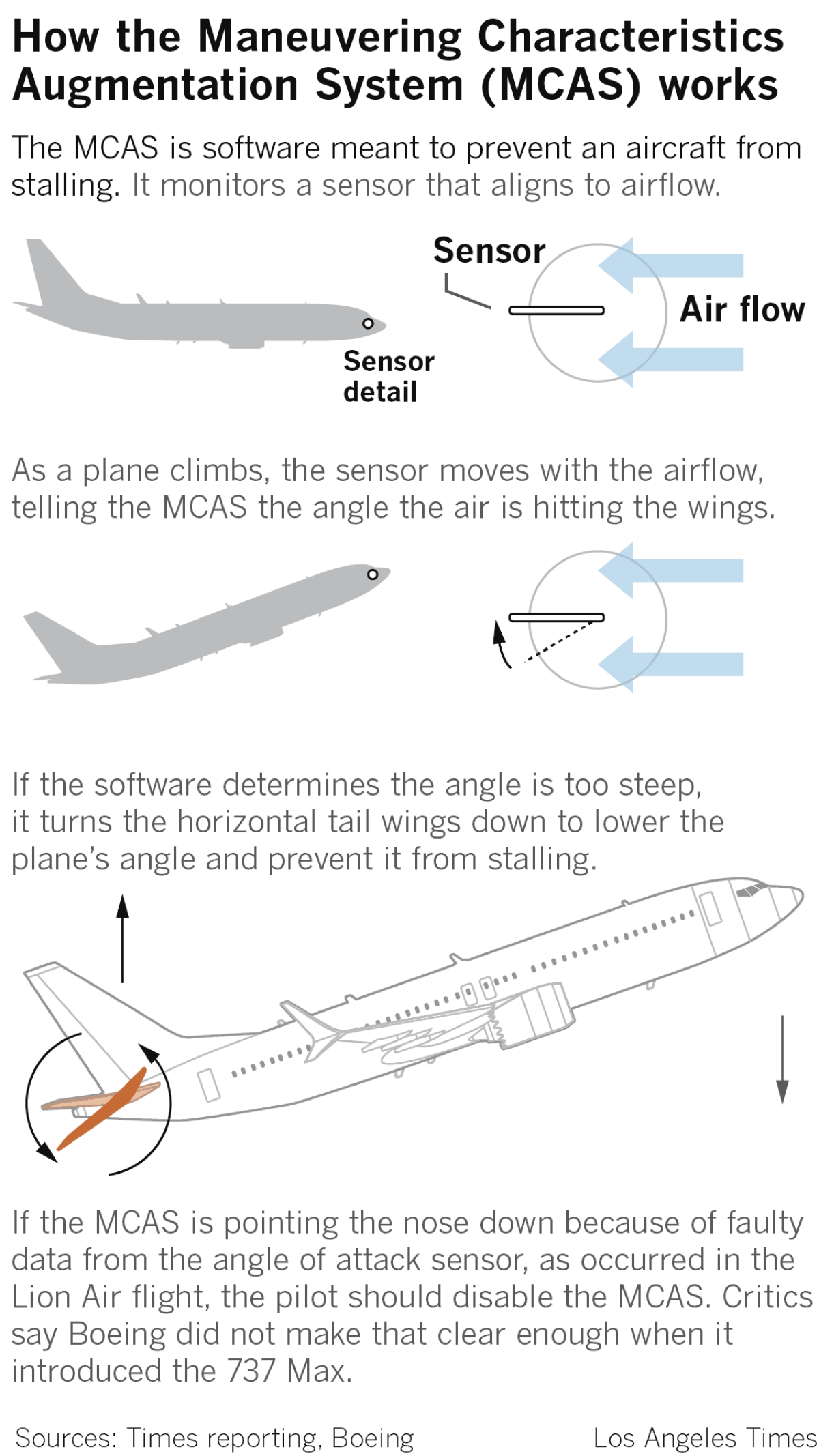What you need to know about the grounded 737 Max

- Share via
Following two deadly crashes, the U.S. joined the rest of the world in temporarily grounding the Boeing 737 Max, the newest version of one of the most popular planes in the world.
The causes of the crashes — one in Indonesia and the latest in Ethiopia — haven’t been determined, but plane manufacturer Boeing Co. agreed with the Federal Aviation Administration’s decision to ground the planes “out of an abundance of caution and to reassure the flying public of the aircraft’s safety.”
For the record:
7:00 p.m. March 14, 2019A previous version of this article said that Southwest’s grounded 737 Max 8 planes flew about 39 daily flights. The correct number is 150.
How have travelers been affected by the grounding?
The three U.S. carriers that fly 737 Max planes — Southwest, American and United Airlines — say the FAA’s decision has had minimal impact on their operations and on their customers. All of the passengers who were scheduled to fly on 737 Max planes have been rebooked on other similar-sized or larger planes at no extra charge or refunded their money. In some cases, airlines said they upgraded passengers to more expensive fares that come with free meals.
Southwest Airlines officials acknowledge there have been some delays for fliers but say that bad weather across the country is contributing to the problems.
Several travelers who were scheduled to fly on 737 Max planes expressed frustration on social media about the delays and confusion.
Why hasn’t the impact on fliers been more significant?
Although Boeing describes the plane as its best-selling model, based on about 5,000 orders, the manufacturer deliveries began fairly recently, in 2017, with 370 planes in commercial use so far.
Which airlines have been most affected by the worldwide grounding of the 737 Max?
Southwest Airlines is the U.S. carrier with the greatest number of 737 Max 8 planes — 34. But that represents only about 4% of its fleet of more than 750 planes, almost all of which are older model 737s. The grounded planes flew about 150 daily flights out of more than 4,000 flights operated by the airline a day.
American Airlines, the world’s largest carrier with more than 960 planes in its fleet, has 24 of the 737 MAX 8 aircraft, which operate 85 flights a day. That is a fraction of the approximately 6,700 daily departures throughout the American Airlines system.
United Airlines has 14 of the 737 Max 9 plane out of more than 770 planes, representing 40 flights a day, out of about 4,800 departures a day.
What does this mean for the future of Boeing?
Industry experts and financial analysts have expressed faith in the stability of Boeing but note that the outlook for the manufacturer could change, depending on what investigators determine caused the two deadly crashes. S&P Global Ratings noted in a report Thursday that Boeing “has a strong financial position and liquidity” and that “we currently do not see any effect on our rating of Boeing.”
Boeing stock dropped sharply on Monday and Tuesday from its high of about $420 before the latest crash in Ethiopia. Shares closed Thursday at $373.30. After the market closed, Boeing said it was pausing delivery of the 737 Max.
S&P Global noted that it would be difficult for any airline to now abandon their orders of Boeing’s 737s and switch to a competing model, such as the Airbus SE A320neo, because it is more efficient to operate a fleet from a single manufacturer.
Has the 737 Max had safety problems in the past?
Following the fatal October crash of the Lion Air flight in Indonesia, Boeing issued a warning about potential issues with an automated anti-stalling system on the 737 Max plane that could push the nose down. Boeing was criticized by pilots and others who said this was not disclosed when the plane was unveiled. Boeing has since announced that it would take several steps to make the planes “even safer,” including updating the flight control software as well as pilot displays, operating manuals and crew training. The company said these changes would be implemented over the coming weeks.
The accidents in Indonesia and Ethiopia involved the 737 Max 8.

What made the 737 Max so popular among airlines?
Boeing marketed the 737 Max as being 14% more fuel efficient than the earlier 737 planes produced in the 1990s, such as the 737 Next Generation 600, 700, 800 and 900.
Boeing attributes the fuel efficiency to new engines built by CFM International, a joint venture between a division of General Electric and a division of Safran of France, and other aerodynamic features, including the winglets that look like shark fins but point up and down on the end of the wings.
As a result, the 737 Max 8 has a range of about 4,000 miles, compared to about 3,370 miles for the older 737 models.
In addition, Boeing said the 737 Max makes less noise on takeoff, compared to its older 737 planes, thanks to acoustic treatments in and around the engines.
How have the planes been used in the U.S.?
The 737 Max is a single-aisle plane that can seat between 172 and 230, depending on the version of the plane and the seat layout. The plane has been manufactured in four versions — the 7,8,9 and 10 — each with the same CFM engine and wingspan but different lengths.
The 737 Max 7 is the shortest, at 116 feet in length, and the 737 Max 10 is the longest at 143 feet long. Southwest and American have primarily used the plane for mid-range and long-haul flights, including transcontinental routes and flights to Mexico from Florida.
To read more about the travel and tourism industries, follow @hugomartin on Twitter.
More to Read
Inside the business of entertainment
The Wide Shot brings you news, analysis and insights on everything from streaming wars to production — and what it all means for the future.
You may occasionally receive promotional content from the Los Angeles Times.













